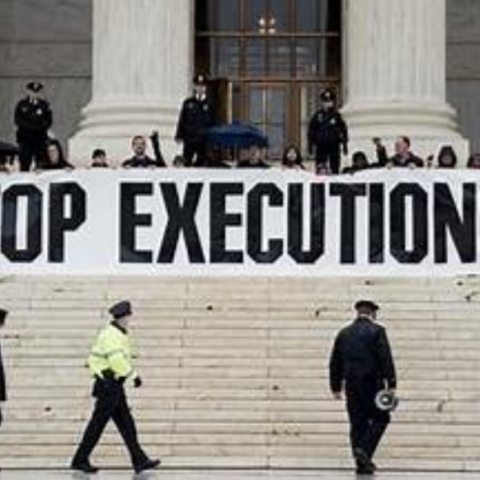By Kristin Fillingim
Over the course of history, society has gradually overturned institutions of inhumanity. From slavery to torture, we continue to abandon practices that are deemed cruel and unusual. In 1948, the United Nations adopted the Universal Declaration of Human Rights (UDHR), which establishes to every individual the right to protection from deprivation of life. It also states that no one shall be subjected to cruel or degrading punishment. As we have adopted this international declaration, it is only fitting that we seriously consider the possibility that the death penalty could possibly violate both of these fundamental rights ensured by the UDHR.
Contrary to the belief of the current Democratic presidential nominee, the 2016 Democratic Party platform outlines its plan to abolish the death penalty. While Hillary Clinton has expressed concern about the application of capital punishment at the state level, she has consistently stated that she sees the value of it on the federal level. Despite her conflicting beliefs, if Clinton becomes president in November, she has the potential to change the course of many lives of those sitting on death row. With the upcoming election and the current vacancy on the Supreme Court, the window of opportunity to abolish capital punishment is forthcoming.
The average age of retirement for Supreme Court justices is 78.7 years old. With three current justices over the age of 78 and one vacant seat, up to four justices have the potential to be appointed by the end of the next presidency. If Clinton appoints all four justices, the Court may have the opportunity to shift to its most liberal position in over 50 years. If the Senate does not approve the appointment of Supreme Court nominee Merrick Garland, Clinton would need to appoint someone with a strong position against the death penalty. This would give liberal justices a 5-4 majority on the Court. If Justice Clarence Thomas and Justice Anthony Kennedy retire in the near future, that could leave Justice John Roberts and Justice Samuel Alito as the only two justices likely to vote against the abolition of the death penalty.
Two current justices have been vocal with their opinions against the death penalty. Both Justice Stephen Breyer and Justice Ruth Bader Ginsburg have publicly spoken out against capital punishment in relation to domestic and global trends. In Justice Breyer’s newest book, “The Court and the World: American Law and the New Global Realities”, he discussed his dissenting opinion on Glossip v. Gross. This was a 2015 Supreme Court case in which petitioners claimed that executions using the “three-drug protocol” violated the Eight Amendment due to the potential pain in the process. The case was brought to the Court in response to the “botched execution of Clayton Lockett.” Locket died 43 minutes after the first of the three-part drug procedure was administered. Midazolam, the drug in question, is used as a sedative, but has not been proven to relieve pain induced by the second and third part of the execution process. Though Lockett is only one of many who have suffered physical trauma due to the drugs administered, the Court ruled in a 5-4 decision that there was not proof that the three-drug method of execution involved the risk of harm.
In forming his opinions, Justice Breyer takes global trends into consideration when deciding when the death penalty should apply and how it is administered. In studies released by Amnesty International, the United States is one of only 22 countries that still use the death penalty. Out of these countries, the United States is one of eight that use it in more than ten cases per year. The Eighth Amendment prohibits the federal government from imposing excessive bail, fines, or cruel and unusual punishment. Considering the Eighth Amendment, Justice Breyer argues that international rule of law should be respected in the definition of “cruel and unusual” punishment. We are in the global minority when it comes to the use of the death penalty, which highlights this practice as “unusual.” From Justice Breyer’s point of view, international law creates an external pressure that beckons our nation to abolish the practice.
Justice Ginsburg points towards a different set of trends when discussing her opinion of capital punishment. She has often pointed back to Furman v. Georgia and contends that if she were on the Court making the decision in 1972, she would have denied the reversal of its decision four years later. In this case, the Court overruled all state death penalty laws, but four years later upheld a Georgia law that prescribed death for specific categories of murder and gave guidance to juries deciding on sentences of punishment. Looking at recent decisions of the Court in cases such as Hurst v. Florida, Hall v. Florida, and Ring v. Arizona, Ginsburg finds that different sentencing processes for capital cases have led to stricter interpretations of constitutionality.
The use of capital punishment within the United States has been on the decline since the 1990s. According to a study released by the Death Penalty Information Center, only 28 people were executed last year, which is the lowest number since 1991. The number of death sentences continues to drop, and the amount of public support has dropped from 80 percent approval in 1994 to only 61 percent approval in 2015. As Justice Ginsburg would point out, these statistics, along with recent Supreme Court decisions, create pressure to change from within.
Abolishing the death penalty could be achieved in a few different ways. States could continue individually abolishing the death sentence, or Congress could pass federal legislation barring the use of capital punishment. However, considering the priorities of lawmakers and executives both at the state and federal level, fighting for the end of this practice will be painstakingly slow and ineffective. The most likely solution to this problem that President Obama has described as “deeply troubling” can be found within the Supreme Court. The end of this punishment may be near depending on the next president’s Supreme Court appointments. If the Democrats gain a majority in the Senate or hold onto the White House, a new liberal majority could have the power in numbers to change the process of sentencing for capital cases. Stepping away from antiquated ideas such as the death penalty would be a step forward for our nation as we continue to move towards universal human rights and accepting established international norms.


